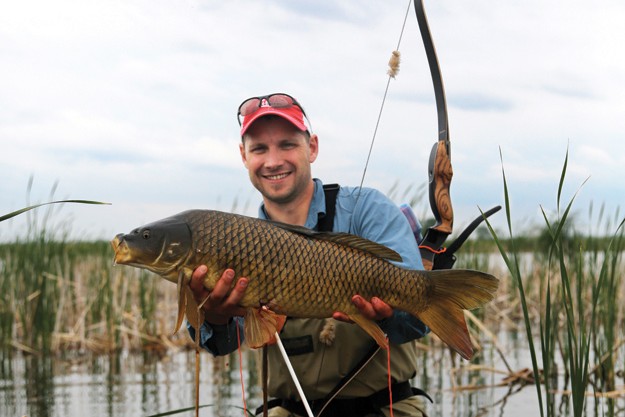Advertisement
Bowfishing combines the outdoor passions of hunting and fishing, and getting started is easier than you might think. One of the most popular target species, the common carp, is both large and widespread, and all you need are a few essential items. Here’s how to get in on the action.
Bow: Choose whatever style of bow you’re most comfortable shooting. Traditional stick-and-string bows offer quick shots when wading and stalking in close, while the let-off relief of a compound allows you to hold out for an opportune shot. Whatever the case, high-speed, top-of-the-line bows aren’t necessary, and a 30- to 50-pound draw weight will suffice.
Advertisement
Reel: There are three styles of reel that fasten to bows, and hold and dispense line. Simple drum reels are the least expensive, but they slow down your arrow and can be tedious to re-spool. Then there are spincast models, which resemble traditional fishing reels, complete with a drag and a linerelease button you must press before shooting. Finally, there’s AMS Bowfishing’s Retriever, which quickly cranks in line and piles it into a plastic bottle. Drum and spincast reels attach to the bow riser’s stabilizer with a threaded insert, while the Retriever comes with custom mounting hardware. At a minimum, your reel should be spooled with 25 metres of brightly coloured, 80-pound-test braided line.
Arrows and rest: For a powerful, penetrating punch, bowfishing requires long, heavy, solid fibreglass arrows weighing 1,100 grains or more. Fletchings are unnecessary because the line stabilizes the arrow while in flight. But you will need to attach so-called safety slides to your arrows. Because the fishing line is attached to the nock, the line gets pulled behind the riser when you draw. If the line then catches on the bow when you release, the arrow can snap back at you. Safety slides prevent this dangerous situation by keeping the line in front of the riser during the draw. That way, the line won’t catch on the bow, and will instead slip back to the end of the shaft after you release. For shooting the heavy arrows, compound bows require durable rests such as the AMS Wave or Whisker Biscuit. Traditional bows can simply shoot off the shelf.
Tip: Like big-game broadheads, fishing arrow tips come in two types: fixed and expandable. Fixed points are best for starting out because they’re simple and reliable, with stainless steel ferrules specially designed for effectively penetrating a carp’s scaly flank.
Advertisement
Shooting: After installing your reel, tune and sight-in your bow, then practise shooting and retrieving on land to get a handle on arrow flight, accuracy and retrieval. For seasoned anglers, spotting carp is easy, especially with polarized sunglasses (another essential item). But bowfishing rookies will quickly learn that targets below the water’s surface aren’t as they appear. The key is to aim low to account for refraction. The deeper or farther away the fish is, the lower you must aim. Taking practice shots at the lake bottom will help you get used to this adjustment.
Tactics: The prolific carp is great for beginners, and shooting them often helps manage their population (but first check the relevant fishing regulations for your region). When spawning during spring and early summer, carp lose their wariness, making it an optimal time to hunt them. Look for the fish cruising clear, warm, shallow water in silt-bottomed rivers, reservoirs or lagoons with plenty of vegetation. Spotting carp is easiest from a higher vantage point, so a stable boat or bridge makes the best platform for ambushing moving fish. After spawning, carp wise up and can be tougher to arrow; the best shooting opportunities come from patiently stalking weedy shoreline shallows, watching for active feeders. You don’t need to wait for a broadside shot, either. No matter what your angle, if you hit the fish between its head and dorsal fin, your arrow will stick—giving you a whole new appreciation of the term “fish on!”
Advertisement

